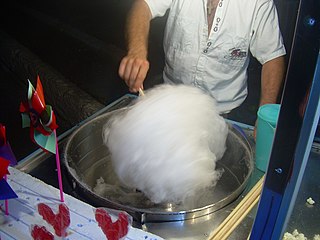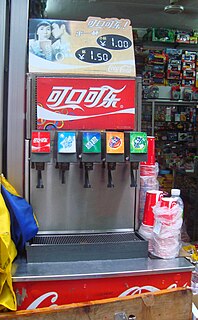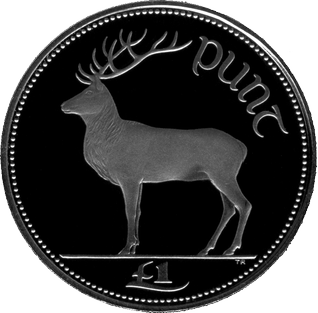
Cotton candy is a spun sugar confection that resembles cotton. It usually contains small amounts of flavoring and/or food coloring.

Office supplies are consumables and equipment regularly used in offices by businesses and other organizations, by individuals engaged in written communications, recordkeeping or bookkeeping, janitorial and cleaning, and for storage of supplies or data. The range of items classified as office supplies varies, and typically includes small, expendable, daily use items, consumable products, small machines, higher cost equipment such as computers, as well as office furniture and art.
Jones Soda Co. is a beverage company based in Seattle, WA. It bottles and distributes soft drinks, non-carbonated beverages, energy drinks, and candy. Jones Cane Sugar Soda is a carbonated soft drink that has many unusual flavors that are not offered by other soft drink makers.

An ice cream van (British) or ice cream truck (American) is a commercial vehicle that serves as a mobile retail outlet for ice cream, usually during the summer. Ice cream vans are often seen parked at public events, or near parks, beaches, or other areas where people congregate. Ice cream vans often travel near where children play — outside schools, in residential areas, or in other locations. They usually stop briefly before moving on to the next street. Along the sides, a large sliding window acts as a serving hatch, and this is often covered with small pictures of the available products, with their associated prices. Most ice cream vans tend to sell both pre-manufactured ice pops in wrappers, and soft serve ice cream from a machine, served in a cone, and often with a chocolate flake or a sugary syrup. While franchises or chains are rare within the ice cream truck community, some do exist.

A soda fountain is a device that dispenses carbonated soft drinks, called fountain drinks. They can be found in restaurants, concession stands and other locations such as convenience stores. The device combines flavored syrup or syrup concentrate and carbon dioxide with chilled and purified water to make soft drinks, either manually, or in a vending machine which is essentially an automated soda fountain that is operated using a soda gun. Today, the syrup often is pumped from a special container called a bag-in-box (BiB).

Container-deposit legislation is any law that requires the collection of a monetary deposit on beverage containers at the point of sale and/or the payment of refund value to the consumers. When the container is returned to an authorized redemption center, or retailer in some jurisdictions, the deposit is partly or fully refunded to the redeemer. It is a deposit-refund system.
The Randolph–Sheppard Act, 20 U.S.C. § 107 et seq., is a federal law which mandates a priority to blind persons to operate vending facilities on Federal property.

Dippin' Dots is an ice cream snack invented by Southern Illinois University Carbondale alumnus, Curt Jones, in 1988. The confection is created by flash freezing ice cream mix in liquid nitrogen. The snack is made by Dippin' Dots, Inc., headquartered in Paducah, Kentucky.

A hawker is a vendor of merchandise that can be easily transported; the term is roughly synonymous with costermonger or peddler. In most places where the term is used, a hawker sells inexpensive goods, handicrafts, or food items. Whether stationary or mobile, hawkers often advertise by loud street cries or chants, and conduct banter with customers, to attract attention and enhance sales.

The Crane Company is an American industrial products company based in Stamford, Connecticut. Founded by Richard Teller Crane, it became a holding company with a diverse portfolio. Its business segments are Aerospace & Electronics, Engineered Materials, Payment and Merchandising Technology, Fluid Handling, and Controls. Industries served by these segments include chemical industries, commercial construction, food and beverage, general and commercial aviation, and power generation. The company was one of the leading manufacturers of bathroom fixtures until 1990, when that division was sold off; it now operates as a brand of American Standard Brands.

The gimlet is a cocktail typically made of 2 parts gin and 1 part lime juice. A 1928 description of the drink was: "gin, a spot of lime, and soda." The description in the 1953 Raymond Chandler novel The Long Goodbye stated that "a real gimlet is half gin and half Rose's lime juice and nothing else." This is in line with the proportions suggested by The Savoy Cocktail Book (1930), which specifies one half Plymouth Gin and one half Rose's Lime Juice Cordial. However, modern tastes are less sweet, and generally provide for at least two parts gin to one part of the lime and other non-alcoholic elements.

The one pound (£1) coin was a coin of the Irish pound. It was used in Ireland from 20 June 1990 until Ireland joined the euro in 2002. The last issue was in 2000.

"Duros de harina" are a popular Mexican snack food made of puffed wheat, often flavored with chilli and lime.
Crane Merchandising Systems is a designer and manufacturer of vending machines. Crane manufactures models sold under such brand names as National Vendors, Automatic Products, GPL, Dixie-Narco, and Stentorfield. Their manufacturing facility is located in Williston, South Carolina, United States.
Monumental Vending is a vending machine operator that has been in business since 1991. The company is based in Beltsville, MD and services the Baltimore and Washington metropolitan region. The company is the largest, private vending company in the region and actively touts its reliance on technology including wireless connectivity to every machine as a key differentiating feature.

Between 1886 and 1959, the price of a 6.5-oz glass or bottle of Coca-Cola was set at five cents, or one nickel, and remained fixed with very little local fluctuation. The Coca-Cola Company was able to maintain this price for several reasons, including bottling contracts the company signed in 1899, advertising, vending machine technology, and a relatively low rate of inflation. The fact that the price of the drink was able to remain the same for over seventy years is especially significant considering the events that occurred during that period, including the founding of Pepsi, World War I, Prohibition, changing taxes, a caffeine and caramel shortage, World War II, and the company's desire to raise its prices. Much of the research on this subject comes from "The Real Thing": Nominal Price Rigidity of the Nickel Coke, 1886–1959, a 2004 paper by economists Daniel Levy and Andrew Young.


















